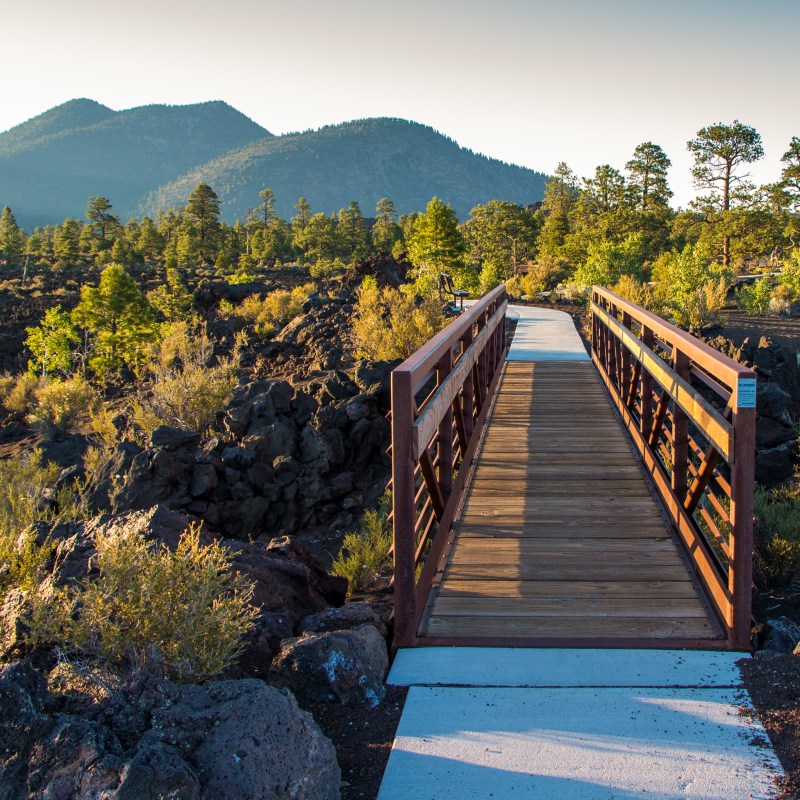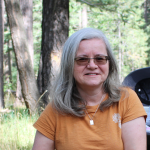
The top of the cinder cone seems to glow in orange, gold, and crimson hues that become even more vibrant as the sun is setting. These colors, so vivid against the black and gray of the cone’s base, gave the volcano its name: Sunset Crater.
Videos by TravelAwaits
Part of the National Park System, Sunset Crater Volcano National Monument showcases and protects one of the youngest volcanoes in the San Francisco Peaks mountain range surrounding Flagstaff, Arizona. Its beauty alone was enough of a reason to enjoy visiting, but there were plenty of other reasons.
However, next time we visit, the surroundings won’t look the same.
Unfortunately, the 2022 wildfire season started early in Arizona. The Tunnel Fire started on April 17, across the highway from Sunset Crater, and extended to the national monument within the first few days. In spite of having only sparse vegetation as fuel, and fire fighters’ efforts, it burned through the park and the adjoining Bonito campground.
When Sunset Crater Volcano National Monument will reopen, it won’t look the same. Still, it will have a different beauty. The crater and the lava field will still be there, but most of the trees will be missing or scorched for a while. They were one of the reasons this park was my favorite, but there are other reasons. Here are a few of them.
Editor’s Note: The National Park Service announced on August 18, 2022 that the Sunset Crater Volcano is partially open with limited services following the Tunnel Wildfire destruction. The Lava Flow and A’a trails are open. The Visitor Center, Lenox Crater and Lava’s Edge Trails, as well as the Cinder Hills Overlook remain closed. For the most up-to-date information, please visit NPS.gov.1. We Learned About Geology And Volcanic Activity
Few places on Earth showcase the aftermath of volcanic activity like Sunset Crater. The monument’s namesake, the youngest crater on the Colorado Plateau at 1,000 feet tall, erupted in 1089. A little less than a millennium later, the surrounding landscape still shows the effects.
And it’s not the only cinder cone this national monument preserves. The 300-foot-tall Lenox Crater is much older, revealing a different stage of volcanic activity. Visiting the park gives you an opportunity to compare the two and learn how volcanic fields form.
Besides the craters themselves, the visitor center offered interactive exhibits that explained volcanic activity, demonstrated earthquakes and eruptions, and gave us all a good understanding of the phenomenon.

2. We Walked Through A Lava Flow
The mile-long interpretive trail loop at the base of Sunset Crater led through the Bonito Lava Flow, showcasing its different features.
When the volcano erupted, its cinders created the cone, but it also ejected large rocks and created lava blocks. Some of them were visible along the trail. Other features of the trail included jagged lava rocks, a sharp fin of basalt rock among them. They formed as the hot magma pushed through fissures in the already cooled surface. A collapsed ice cave, or lava tube, offered an opportunity to stop and feel cool air coming to the surface.
Other trails with similar and even more spectacular lava formations included the Lava’s Edge Trail and the A’a Trail, named for the rough basaltic lava on it.
3. We Hiked Up To The Bowl Of A Cinder Cone
Though we could never climb Sunset Crater, we could walk up to the top and even inside a cinder cone taking the trail on Lenox Crater. The 1.6-mile round-trip trail to the top of the crater was shaded by tall ponderosa pines and featured switchbacks on black sand and lava pebbles. At the top, we could see inside the bowl of the cinder cone, offering a better understanding of how it was formed. But my favorite reason to hike up the crater was the perfect view of the San Francisco Peaks and their surroundings.

4. I Loved Seeing How Nature Could Renew Itself
Everywhere I looked in and around Sunset Crater, I noticed signs of nature slowly renewing itself. It took more than 400 years for the first plants to return to the area after the eruption, and we were eventually walking in a Ponderosa pine forest. However, most of the land around the volcano remained barren, so the fire of 2022 didn’t have much fuel.
I always enjoyed the few strands of aspens and tiny ponderosa pines surrounded by black lava rock and delicate flowers in the spring. Some of these flowers could only be found here, like the Sunset Crater penstemon, its bright colors contrasting sharply with the black sand it grows out of. Especially when I visit in spring, it always strikes me how resilient nature is, and how it returns even after the most devastating catastrophes.
5. It Offered Wildlife And Bird-Watching Opportunities
The islands of vegetation in the middle of this lava-filled land provides habitats for a variety of wildlife. When we sat down long enough, we noticed some of the area’s inhabitants.
Chipmunks were running around in the lava flow, along with gray Abert’s squirrels with their tassel-tipped ears. In the Bonito Meadow we used to see prairie dogs, and on early mornings or late afternoons, we sometimes noticed larger mammals, including mule deer, elk, and even pronghorn.
Among the birds living in and around Sunset Crater, we enjoyed seeing the large, bright blue Steller’s jays, as well as ravens, crows, hawks, golden eagles, and plenty of hummingbirds.

6. We Loved Camping On A Lava Flow
For the best chance to see wildlife and the night sky, we used to camp at the Bonito Campground on the lava flow in the shadow of tall ponderosa pines.
Walking around the site, I loved the sound and feel of the black pebbles crunching under my feet. I watched Steller’s jays and ravens perched on the trees above, and fast-moving chipmunks and Abert’s squirrels running around with pinecones in their mouths. Several trails started at the campground, offering hiking opportunities.
7. We Participated In Several Outstanding Ranger-Led Programs
Rangers and volunteers used to hold seasonal interpretive programs at the campground’s Bonito Flow Amphitheater. Topics would vary, but the programs always offered great opportunities to learn about the surrounding High Country of Arizona. Over time, we learned about volcanoes, wildlife, nature, conservation, wildfires, mudslides, ancient or modern history, and geology. It was the best classroom for our school-aged children, and given the consistency of our visits, it was the place they learned most about these subjects.
8. We Enjoyed Watching The Gorgeous Dark Night Skies – With Or Without Telescopes
We used to stay up very late while camping to enjoy some of the most amazing night skies in the world. Far from light pollution, Sunset Crater Volcano National Monument is an International Dark Sky Park, where all the celestial bodies look clear and bright, especially on a moonless night.
On a few occasions, we joined astronomers from Flagstaff sitting out in front of the visitor center with their telescopes. They held star parties there, sharing their telescopes and talking about the celestial objects we could see through them, helping us understand the incredible night sky around Sunset Crater.

9. We Appreciated Learning About The Area’s Interesting Human History
People lived in the Sunset Crater area long before the volcano erupted. After losing their homes and crops, they moved, leaving the ruins of their old lives behind. These ruins still stand, preserved at Wupatki National Monument.
A few centuries later, nature returned, and by the 19th century, the area was attracting people again. First came the explorers, among them John Wesley Powell, who named the cinder cone when he noticed its colors. Ranchers, miners, loggers, and tourists followed, endangering the delicate ecosystem still struggling to survive.
In 1928, a movie company wanted to blow up Sunset Crater to film a landslide. Local groups intervened and pushed for protecting the cinder cone. Thanks to them, President Herbert Hoover established Sunset Crater Volcano National Monument in 1930.
10. Camping At Sunset Crater Gave Us An Opportunity To Unplug
The area in and around Sunset Crater has no cell phone service and no Internet. So when we were there, regardless of whether we were just passing through or staying the night at the campground, we had no choice but to unplug. In this age of constant electronic communication, it was nice to be unavailable and unable to read the news. Especially when we were camping, spending time there gave us the opportunity to enjoy a peaceful time in nature.
Be sure to check out these amazing national park destinations:
